Ethnic culture thrives in Aba Tibetan and Qiang Autonomous Prefecture, SW China
Xinhua
1592961704000
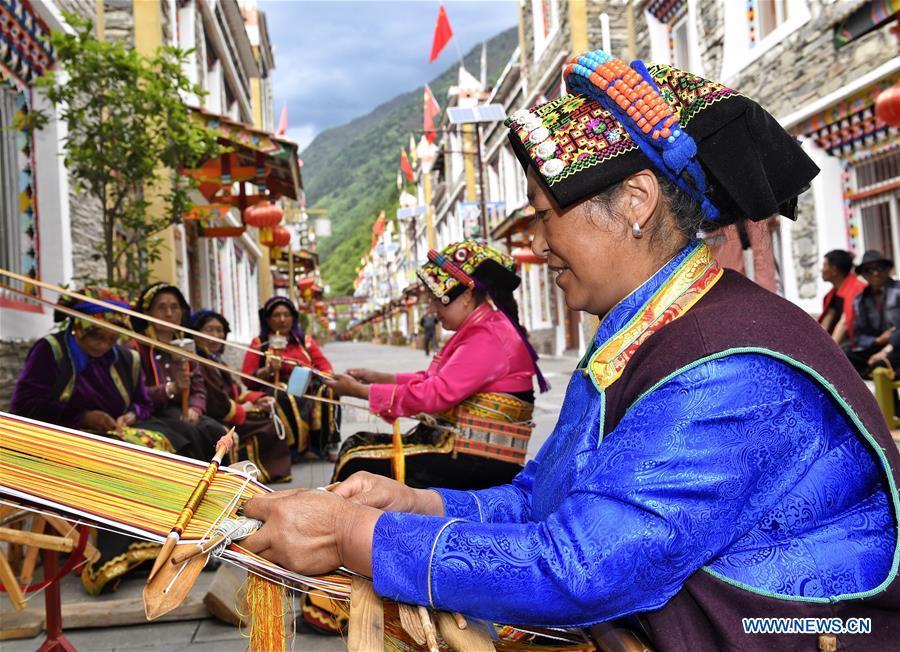
Villagers weave traditional belts in Lixian County of Aba Tibetan and Qiang Autonomous Prefecture, southwest China's Sichuan Province, June 11, 2020. Located in northwest of Sichuan Province, with nearly one million population, Aba Tibetan and Qiang Autonomous Prefecture has a diversity of ethnic minority groups, including Tibetan, Qiang and Hui, etc. In recent years, to better inherit the ethnic culture, local schools have introduced more traditional cultural courses while local authorities set up training workshops about intangible cultural heritage to help local villagers learn traditional crafts, as a way to boost their incomes. In 2018, the production value of cultural industry in this prefecture has reached about 1.2 billion yuan (about 169.8 million U.S. dollars), accounting for 3.32 percent of gross domestic product (GDP) of this prefecture. (Xinhua/Liu Kun)
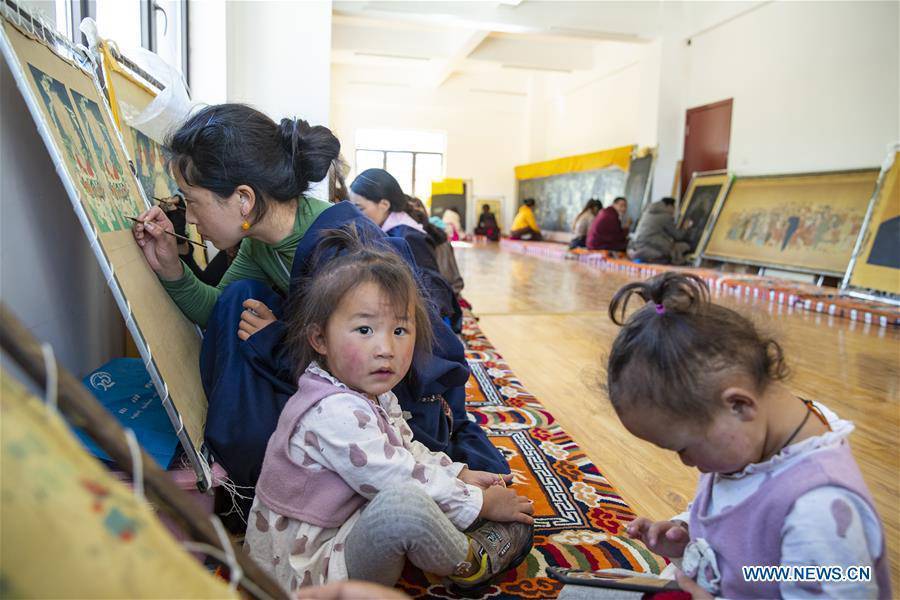
A villager accompanied by her twin daughters creates a Tangka painting at a workshop where villagers can learn traditional crafts for free in Rangtang County of Aba Tibetan and Qiang Autonomous Prefecture, southwest China's Sichuan Province, June 13, 2020. Located in northwest of Sichuan Province, with nearly one million population, Aba Tibetan and Qiang Autonomous Prefecture has a diversity of ethnic minority groups, including Tibetan, Qiang and Hui, etc. In recent years, to better inherit the ethnic culture, local schools have introduced more traditional cultural courses while local authorities set up training workshops about intangible cultural heritage to help local villagers learn traditional crafts, as a way to boost their incomes. In 2018, the production value of cultural industry in this prefecture has reached about 1.2 billion yuan (about 169.8 million U.S. dollars), accounting for 3.32 percent of gross domestic product (GDP) of this prefecture. (Xinhua/Shen Bohan)
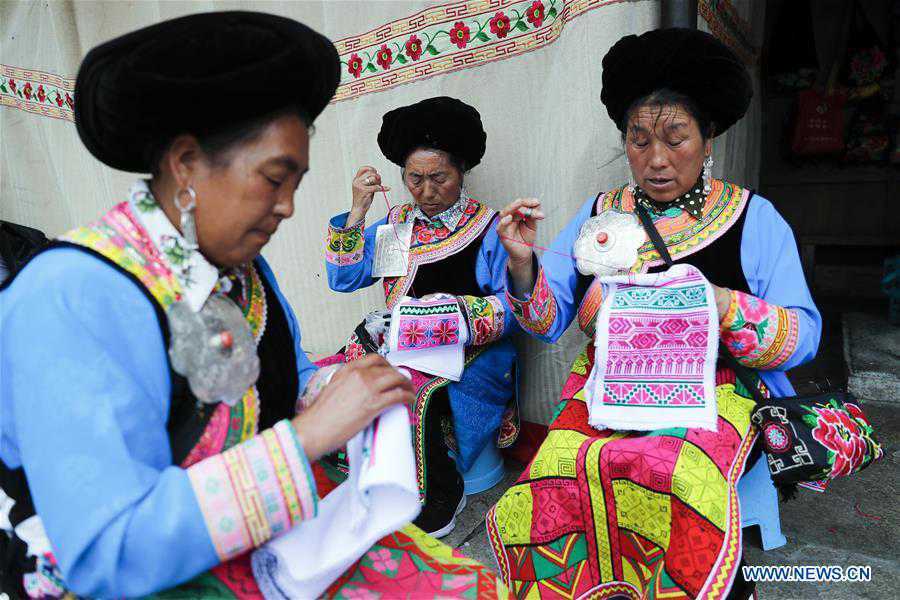
Villagers make embroidery of Qiang ethnic group in Maoxian County of Aba Tibetan and Qiang Autonomous Prefecture, southwest China's Sichuan Province, June 22, 2020. Located in northwest of Sichuan Province, with nearly one million population, Aba Tibetan and Qiang Autonomous Prefecture has a diversity of ethnic minority groups, including Tibetan, Qiang and Hui, etc. In recent years, to better inherit the ethnic culture, local schools have introduced more traditional cultural courses while local authorities set up training workshops about intangible cultural heritage to help local villagers learn traditional crafts, as a way to boost their incomes. In 2018, the production value of cultural industry in this prefecture has reached about 1.2 billion yuan (about 169.8 million U.S. dollars), accounting for 3.32 percent of gross domestic product (GDP) of this prefecture. (Xinhua/Shen Bohan)
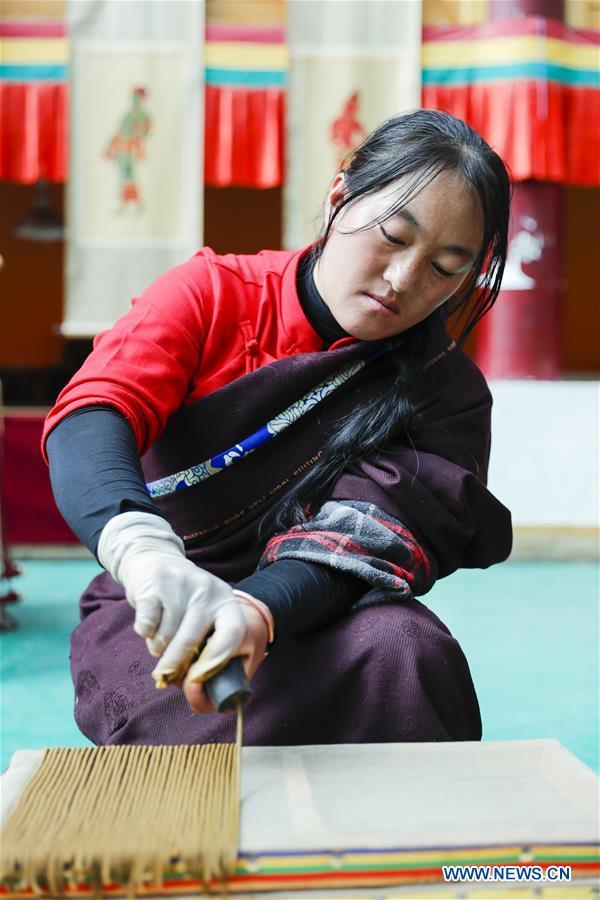
A villager makes Tibetan incense at a workshop where villagers can learn traditional crafts for free in Rangtang County of Aba Tibetan and Qiang Autonomous Prefecture, southwest China's Sichuan Province, June 13, 2020. Located in northwest of Sichuan Province, with nearly one million population, Aba Tibetan and Qiang Autonomous Prefecture has a diversity of ethnic minority groups, including Tibetan, Qiang and Hui, etc. In recent years, to better inherit the ethnic culture, local schools have introduced more traditional cultural courses while local authorities set up training workshops about intangible cultural heritage to help local villagers learn traditional crafts, as a way to boost their incomes. In 2018, the production value of cultural industry in this prefecture has reached about 1.2 billion yuan (about 169.8 million U.S. dollars), accounting for 3.32 percent of gross domestic product (GDP) of this prefecture. (Xinhua/Shen Bohan)

Dancers perform a traditional opera on stage in Aba County of Aba Tibetan and Qiang Autonomous Prefecture, southwest China's Sichuan Province, June 14, 2020. Located in northwest of Sichuan Province, with nearly one million population, Aba Tibetan and Qiang Autonomous Prefecture has a diversity of ethnic minority groups, including Tibetan, Qiang and Hui, etc. In recent years, to better inherit the ethnic culture, local schools have introduced more traditional cultural courses while local authorities set up training workshops about intangible cultural heritage to help local villagers learn traditional crafts, as a way to boost their incomes. In 2018, the production value of cultural industry in this prefecture has reached about 1.2 billion yuan (about 169.8 million U.S. dollars), accounting for 3.32 percent of gross domestic product (GDP) of this prefecture. (Xinhua/Liu Kun)

Students create a Tangka painting at a workshop where villagers can learn traditional crafts for free in Rangtang County of Aba Tibetan and Qiang Autonomous Prefecture, southwest China's Sichuan Province, June 13, 2020. Located in northwest of Sichuan Province, with nearly one million population, Aba Tibetan and Qiang Autonomous Prefecture has a diversity of ethnic minority groups, including Tibetan, Qiang and Hui, etc. In recent years, to better inherit the ethnic culture, local schools have introduced more traditional cultural courses while local authorities set up training workshops about intangible cultural heritage to help local villagers learn traditional crafts, as a way to boost their incomes. In 2018, the production value of cultural industry in this prefecture has reached about 1.2 billion yuan (about 169.8 million U.S. dollars), accounting for 3.32 percent of gross domestic product (GDP) of this prefecture. (Xinhua/Liu Kun)
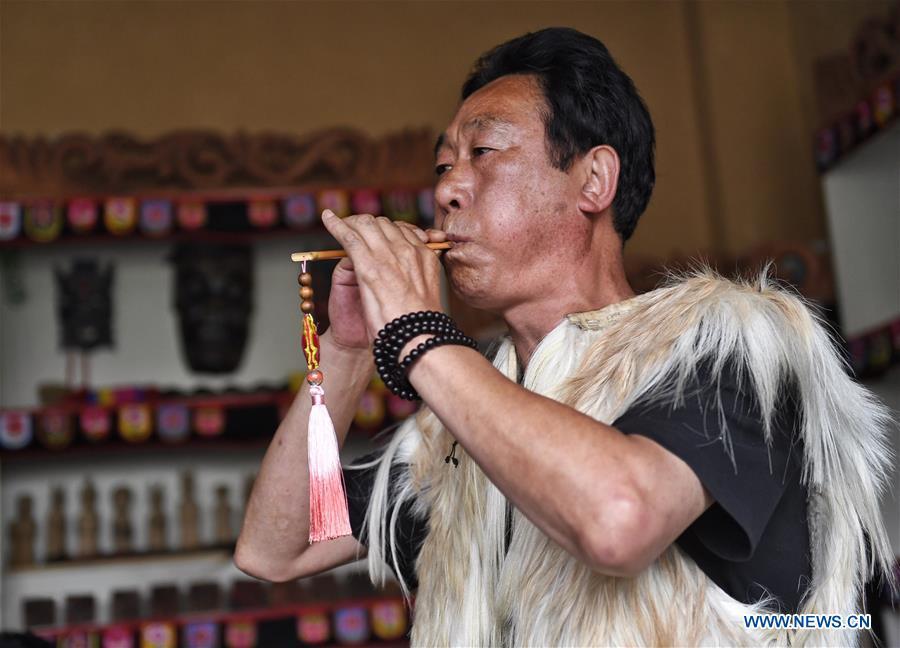
Artist He Wangjin plays flute of Qiang ethnic group at a workshop about intangible cultural heritage in Maoxian County of Aba Tibetan and Qiang Autonomous Prefecture, southwest China's Sichuan Province, June 22, 2020. Located in northwest of Sichuan Province, with nearly one million population, Aba Tibetan and Qiang Autonomous Prefecture has a diversity of ethnic minority groups, including Tibetan, Qiang and Hui, etc. In recent years, to better inherit the ethnic culture, local schools have introduced more traditional cultural courses while local authorities set up training workshops about intangible cultural heritage to help local villagers learn traditional crafts, as a way to boost their incomes. In 2018, the production value of cultural industry in this prefecture has reached about 1.2 billion yuan (about 169.8 million U.S. dollars), accounting for 3.32 percent of gross domestic product (GDP) of this prefecture. (Xinhua/Liu Kun)
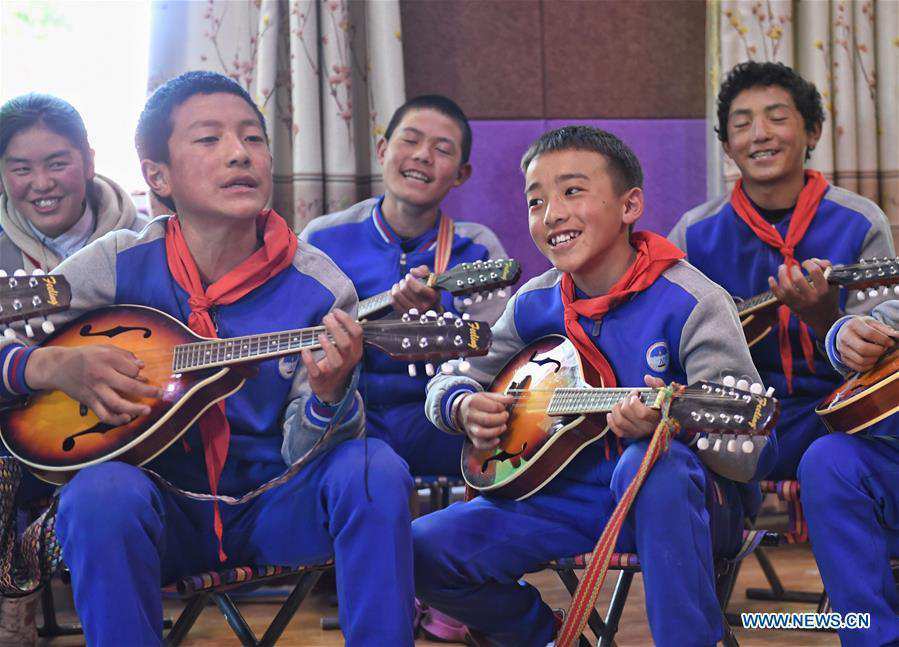
Students learn to play traditional musical instruments in a primary school in Aba County of Aba Tibetan and Qiang Autonomous Prefecture, southwest China's Sichuan Province, June 14, 2020. Located in northwest of Sichuan Province, with nearly one million population, Aba Tibetan and Qiang Autonomous Prefecture has a diversity of ethnic minority groups, including Tibetan, Qiang and Hui, etc. In recent years, to better inherit the ethnic culture, local schools have introduced more traditional cultural courses while local authorities set up training workshops about intangible cultural heritage to help local villagers learn traditional crafts, as a way to boost their incomes. In 2018, the production value of cultural industry in this prefecture has reached about 1.2 billion yuan (about 169.8 million U.S. dollars), accounting for 3.32 percent of gross domestic product (GDP) of this prefecture. (Xinhua/Liu Kun)
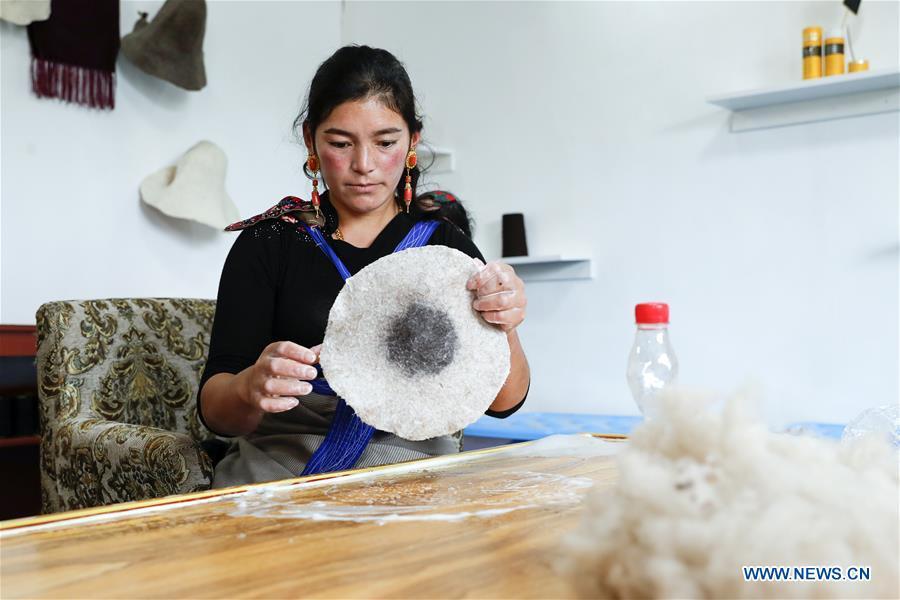
A villager, with her five-month-old daughter on back, makes a yak wool product at a workshop in Ruoergai County of Aba Tibetan and Qiang Autonomous Prefecture, southwest China's Sichuan Province, June 17, 2020. Located in northwest of Sichuan Province, with nearly one million population, Aba Tibetan and Qiang Autonomous Prefecture has a diversity of ethnic minority groups, including Tibetan, Qiang and Hui, etc. In recent years, to better inherit the ethnic culture, local schools have introduced more traditional cultural courses while local authorities set up training workshops about intangible cultural heritage to help local villagers learn traditional crafts, as a way to boost their incomes. In 2018, the production value of cultural industry in this prefecture has reached about 1.2 billion yuan (about 169.8 million U.S. dollars), accounting for 3.32 percent of gross domestic product (GDP) of this prefecture. (Xinhua/Shen Bohan)

Villagers make Tibetan pottery products at a workshop where villagers can learn traditional crafts for free in Rangtang County of Aba Tibetan and Qiang Autonomous Prefecture, southwest China's Sichuan Province, June 13, 2020. Located in northwest of Sichuan Province, with nearly one million population, Aba Tibetan and Qiang Autonomous Prefecture has a diversity of ethnic minority groups, including Tibetan, Qiang and Hui, etc. In recent years, to better inherit the ethnic culture, local schools have introduced more traditional cultural courses while local authorities set up training workshops about intangible cultural heritage to help local villagers learn traditional crafts, as a way to boost their incomes. In 2018, the production value of cultural industry in this prefecture has reached about 1.2 billion yuan (about 169.8 million U.S. dollars), accounting for 3.32 percent of gross domestic product (GDP) of this prefecture. (Xinhua/Shen Bohan)
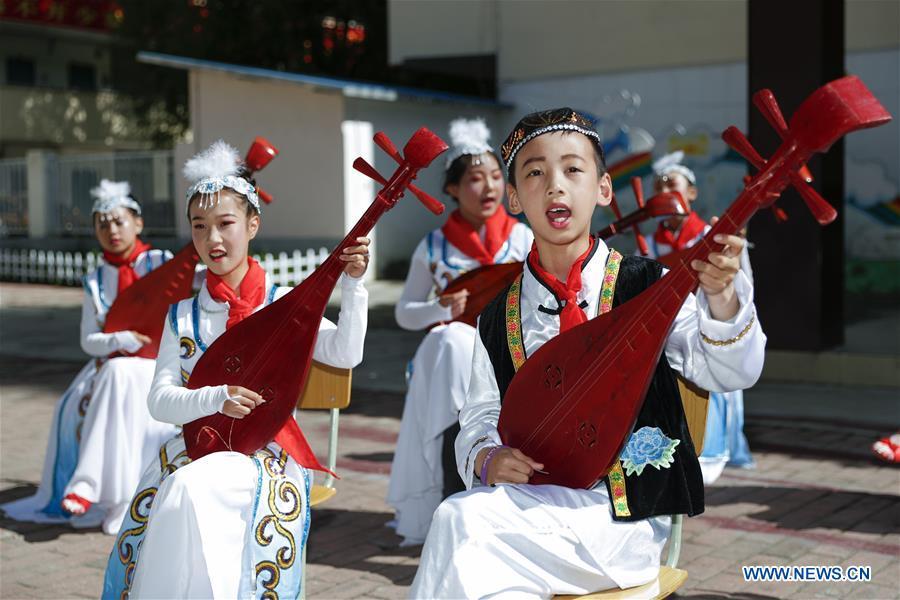
Students play traditional musical instruments of Hui ethnic group in a primary school in Songpan County of Aba Tibetan and Qiang Autonomous Prefecture, southwest China's Sichuan Province, June 18, 2020. Located in northwest of Sichuan Province, with nearly one million population, Aba Tibetan and Qiang Autonomous Prefecture has a diversity of ethnic minority groups, including Tibetan, Qiang and Hui, etc. In recent years, to better inherit the ethnic culture, local schools have introduced more traditional cultural courses while local authorities set up training workshops about intangible cultural heritage to help local villagers learn traditional crafts, as a way to boost their incomes. In 2018, the production value of cultural industry in this prefecture has reached about 1.2 billion yuan (about 169.8 million U.S. dollars), accounting for 3.32 percent of gross domestic product (GDP) of this prefecture. (Xinhua/Shen Bohan)

Dancers perform a traditional opera on stage in Aba County of Aba Tibetan and Qiang Autonomous Prefecture, southwest China's Sichuan Province, June 14, 2020. Located in northwest of Sichuan Province, with nearly one million population, Aba Tibetan and Qiang Autonomous Prefecture has a diversity of ethnic minority groups, including Tibetan, Qiang and Hui, etc. In recent years, to better inherit the ethnic culture, local schools have introduced more traditional cultural courses while local authorities set up training workshops about intangible cultural heritage to help local villagers learn traditional crafts, as a way to boost their incomes. In 2018, the production value of cultural industry in this prefecture has reached about 1.2 billion yuan (about 169.8 million U.S. dollars), accounting for 3.32 percent of gross domestic product (GDP) of this prefecture. (Xinhua/Liu Kun)
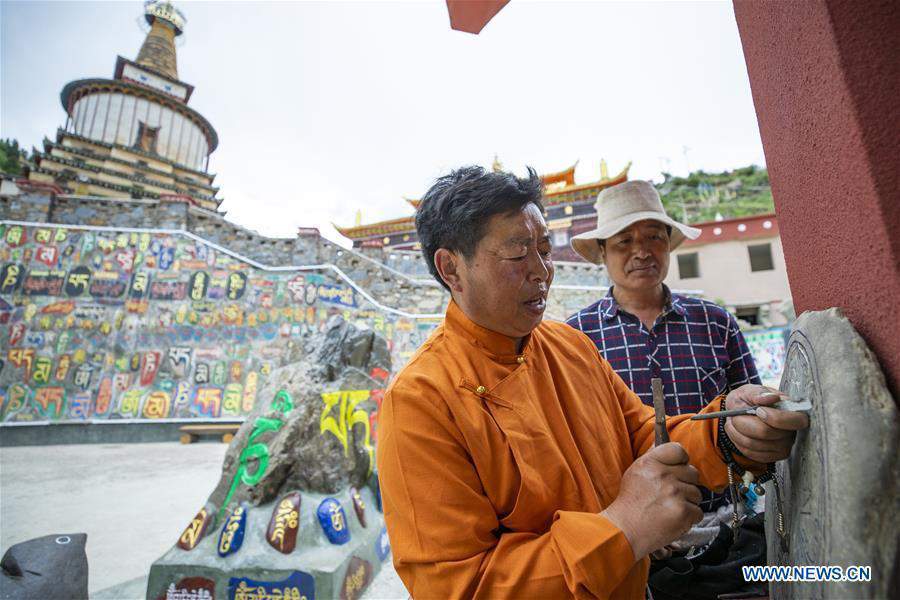
An artist (L) carves a stone as a learner looks on at a sotne carving park in Rangtang County of Aba Tibetan and Qiang Autonomous Prefecture, southwest China's Sichuan Province, June 13, 2020. Located in northwest of Sichuan Province, with nearly one million population, Aba Tibetan and Qiang Autonomous Prefecture has a diversity of ethnic minority groups, including Tibetan, Qiang and Hui, etc. In recent years, to better inherit the ethnic culture, local schools have introduced more traditional cultural courses while local authorities set up training workshops about intangible cultural heritage to help local villagers learn traditional crafts, as a way to boost their incomes. In 2018, the production value of cultural industry in this prefecture has reached about 1.2 billion yuan (about 169.8 million U.S. dollars), accounting for 3.32 percent of gross domestic product (GDP) of this prefecture. (Xinhua/Shen Bohan)
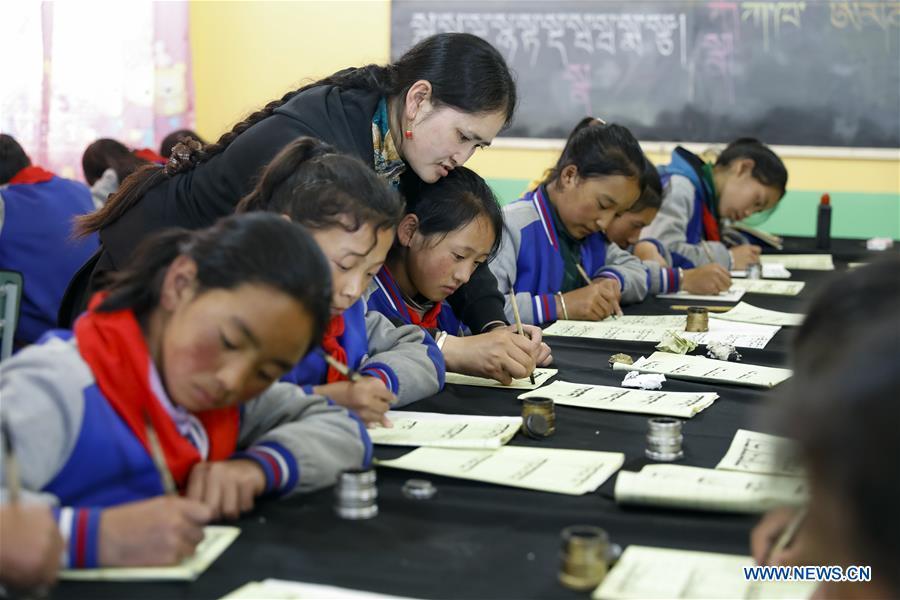
A teacher instructs as students learn Tibetan calligraphy in a primary school in Aba County of Aba Tibetan and Qiang Autonomous Prefecture, southwest China's Sichuan Province, June 14, 2020. Located in northwest of Sichuan Province, with nearly one million population, Aba Tibetan and Qiang Autonomous Prefecture has a diversity of ethnic minority groups, including Tibetan, Qiang and Hui, etc. In recent years, to better inherit the ethnic culture, local schools have introduced more traditional cultural courses while local authorities set up training workshops about intangible cultural heritage to help local villagers learn traditional crafts, as a way to boost their incomes. In 2018, the production value of cultural industry in this prefecture has reached about 1.2 billion yuan (about 169.8 million U.S. dollars), accounting for 3.32 percent of gross domestic product (GDP) of this prefecture. (Xinhua/Shen Bohan)
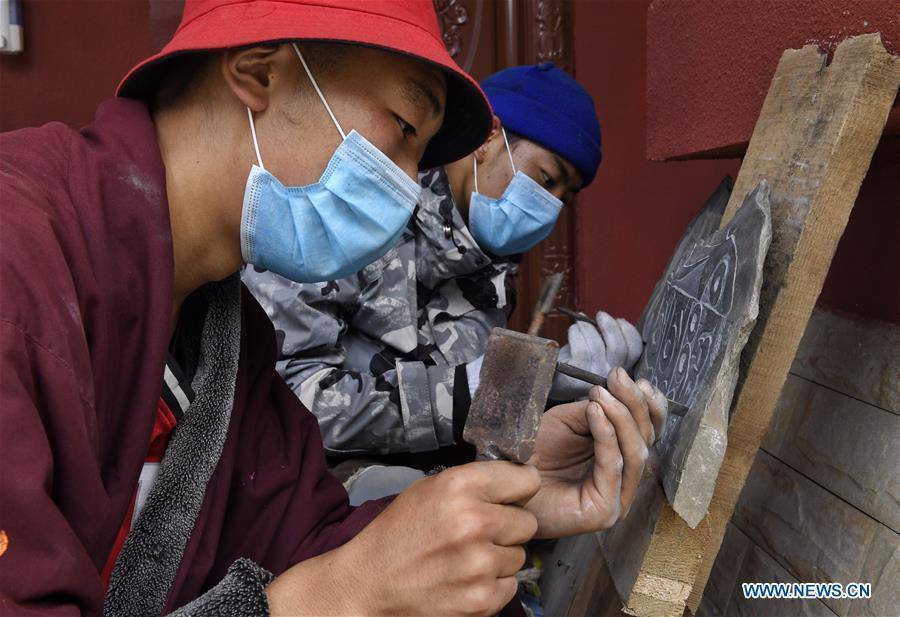
Villagers carve a stone that will be sold as an artwork at a stone carving park in Rangtang County of Aba Tibetan and Qiang Autonomous Prefecture, southwest China's Sichuan Province, June 13, 2020. Located in northwest of Sichuan Province, with nearly one million population, Aba Tibetan and Qiang Autonomous Prefecture has a diversity of ethnic minority groups, including Tibetan, Qiang and Hui, etc. In recent years, to better inherit the ethnic culture, local schools have introduced more traditional cultural courses while local authorities set up training workshops about intangible cultural heritage to help local villagers learn traditional crafts, as a way to boost their incomes. In 2018, the production value of cultural industry in this prefecture has reached about 1.2 billion yuan (about 169.8 million U.S. dollars), accounting for 3.32 percent of gross domestic product (GDP) of this prefecture. (Xinhua/Liu Kun)
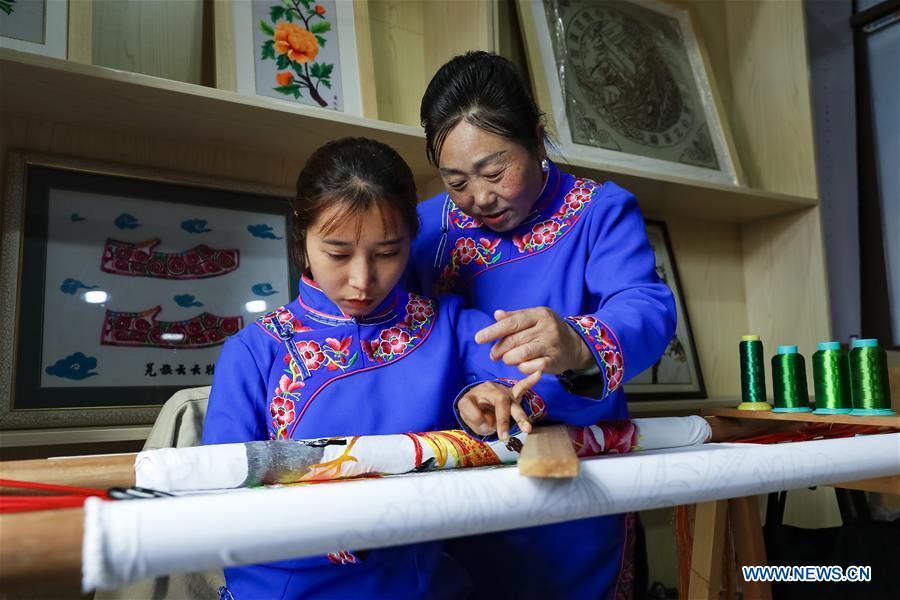
Li Xingxiu (R), intangible cultural heritage inheritor of embroidery of Qiang ethnic group, teaches a villager to make traditional embroidery product at a workshop about intangible cultural heritage in Maoxian County of Aba Tibetan and Qiang Autonomous Prefecture, southwest China's Sichuan Province, June 22, 2020. Located in northwest of Sichuan Province, with nearly one million population, Aba Tibetan and Qiang Autonomous Prefecture has a diversity of ethnic minority groups, including Tibetan, Qiang and Hui, etc. In recent years, to better inherit the ethnic culture, local schools have introduced more traditional cultural courses while local authorities set up training workshops about intangible cultural heritage to help local villagers learn traditional crafts, as a way to boost their incomes. In 2018, the production value of cultural industry in this prefecture has reached about 1.2 billion yuan (about 169.8 million U.S. dollars), accounting for 3.32 percent of gross domestic produc
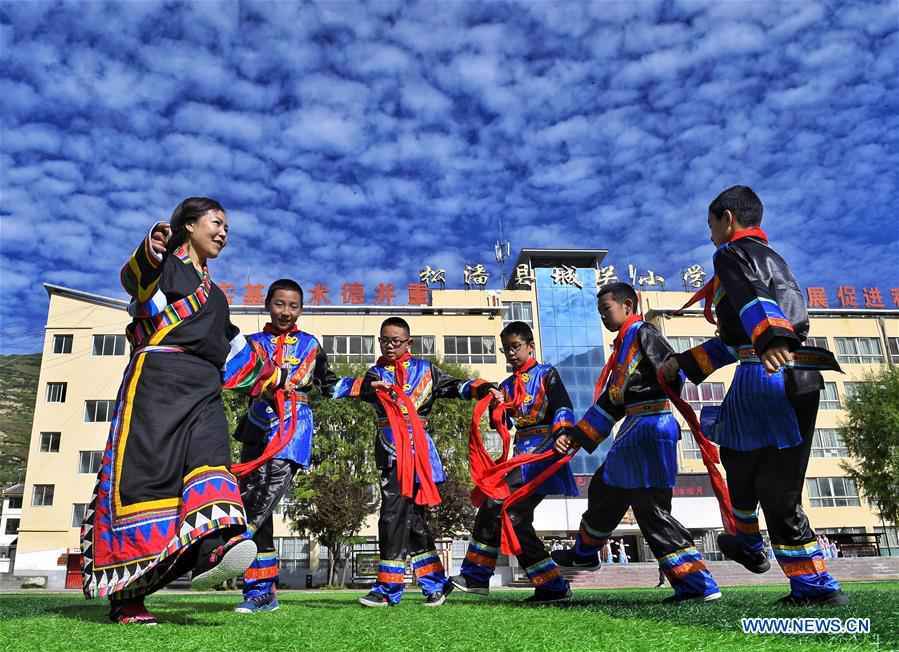
A teacher (1st L) and students perform dance of Qiang ethnic group in a primary school in Songpan County of Aba Tibetan and Qiang Autonomous Prefecture, southwest China's Sichuan Province, June 18, 2020. Located in northwest of Sichuan Province, with nearly one million population, Aba Tibetan and Qiang Autonomous Prefecture has a diversity of ethnic minority groups, including Tibetan, Qiang and Hui, etc. In recent years, to better inherit the ethnic culture, local schools have introduced more traditional cultural courses while local authorities set up training workshops about intangible cultural heritage to help local villagers learn traditional crafts, as a way to boost their incomes. In 2018, the production value of cultural industry in this prefecture has reached about 1.2 billion yuan (about 169.8 million U.S. dollars), accounting for 3.32 percent of gross domestic product (GDP) of this prefecture. (Xinhua/Liu Kun)

Students learn a traditional Tibetan dance in a primary school in Aba County of Aba Tibetan and Qiang Autonomous Prefecture, southwest China's Sichuan Province, June 14, 2020. Located in northwest of Sichuan Province, with nearly one million population, Aba Tibetan and Qiang Autonomous Prefecture has a diversity of ethnic minority groups, including Tibetan, Qiang and Hui, etc. In recent years, to better inherit the ethnic culture, local schools have introduced more traditional cultural courses while local authorities set up training workshops about intangible cultural heritage to help local villagers learn traditional crafts, as a way to boost their incomes. In 2018, the production value of cultural industry in this prefecture has reached about 1.2 billion yuan (about 169.8 million U.S. dollars), accounting for 3.32 percent of gross domestic product (GDP) of this prefecture. (Xinhua/Liu Kun)


